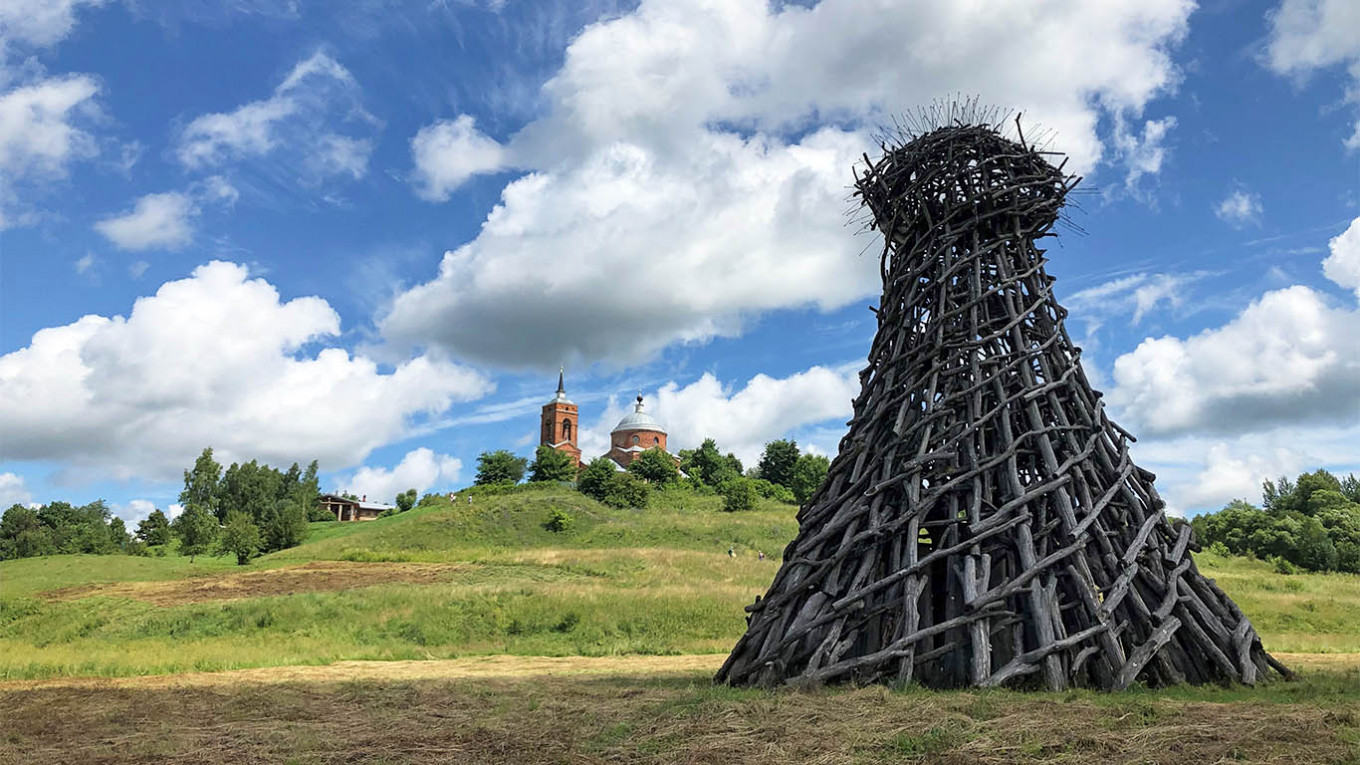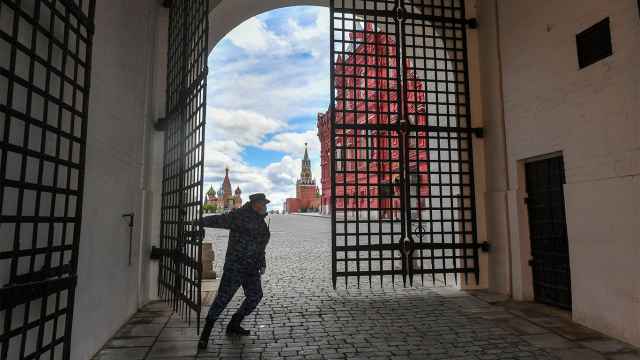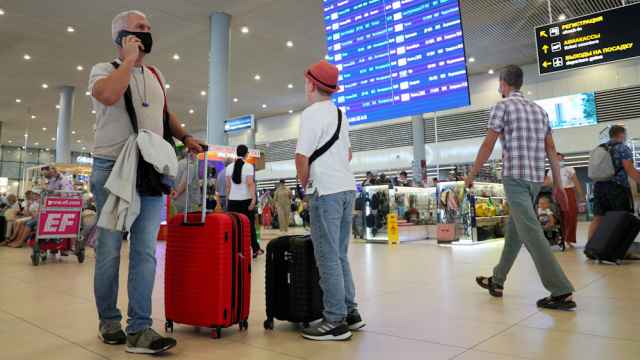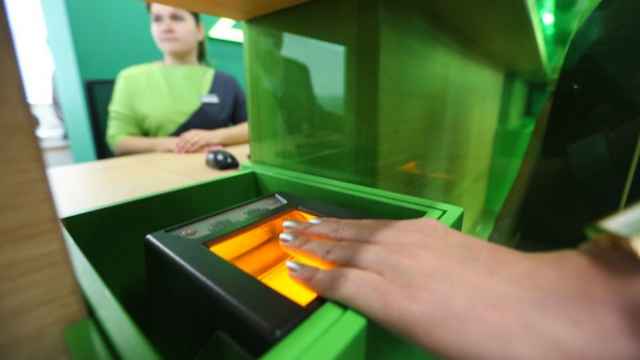After four months of coronavirus lockdown and counting, we all could use an escape from Moscow’s urban expanse.
Nikola-Lenivets, a sprawling open-air art park filled with wonders both natural and manmade, is a great option for getting away from the noise without breaking social distancing.
Covering 650 hectares of Ugra National Park in the Kaluga region southwest of Moscow, this area’s previous claim to fame was its role as the spot where, in 1480, Ivan the Great defeated forces fighting for Mongol leader Akhmat Khan, effectively ending the Mongol and Tatar dominance over Moscow.
Artist Nikolay Polissky arrived here in the late 1980s, using the landscape as inspiration for his paintings. By 2000, he decided to establish a community of artists to transform the site into an exhibition space for “land art,” or art that’s created in harmony with the landscape around it.
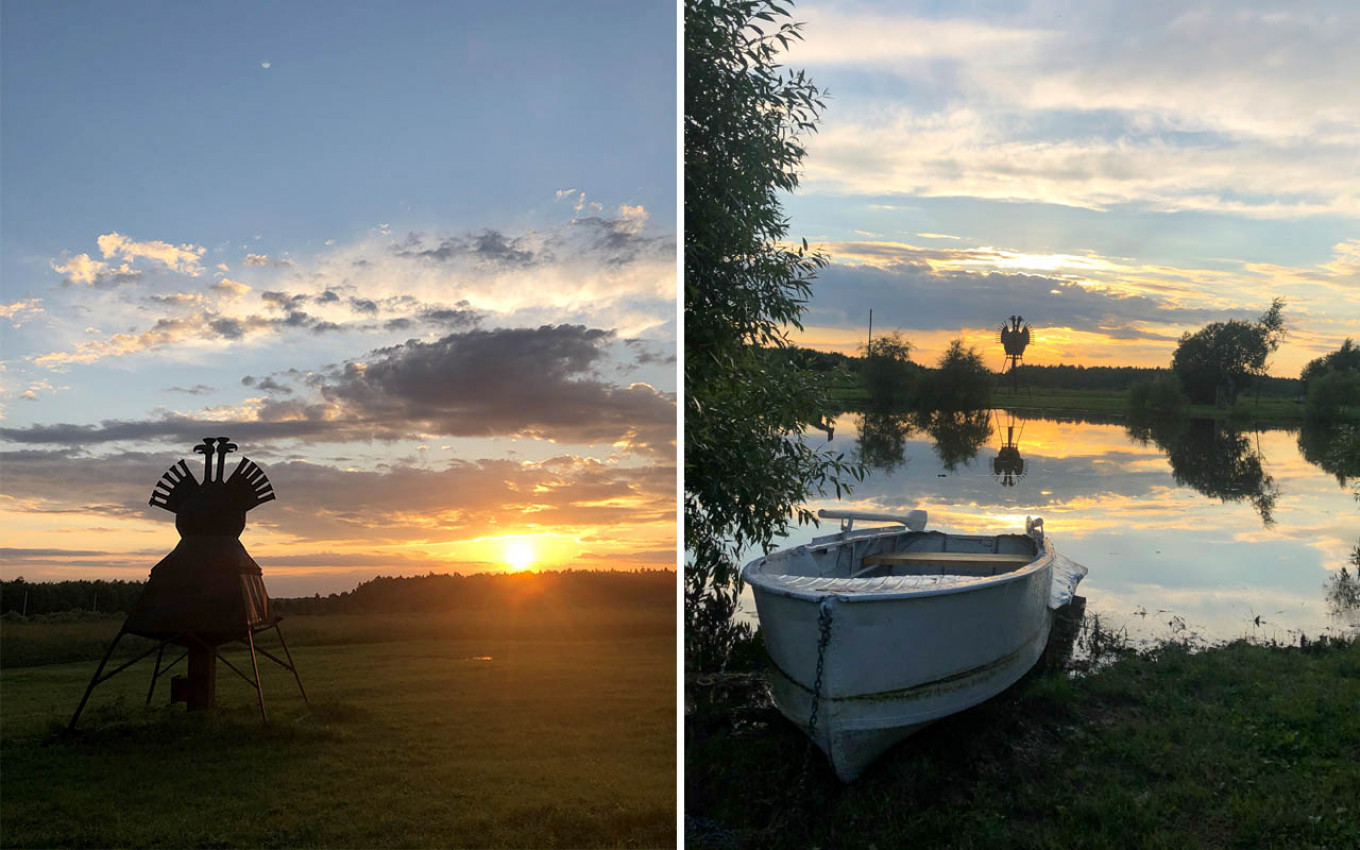
Today, Nikola-Lenivets bills itself as the largest art park in Europe. With its environmental focus, ethos of artistic community and festivals that look like something out of Midsommar, it’s easy to view this place as some kind of Russian Portlandia — but it’s also so much more.
It’s a great spot for families, couples, groups of friends or solo travelers to spend a couple of days, with a friendly, relaxed atmosphere that brings many Muscovites back year after year.
Crafted from wood, metal and stone, the more than 30 permanent art installations at Nikola-Lenivets aren’t just fodder for our Instagram feeds (though they are great for that). They’re meditations on how humans can add beauty into the world around us rather than simply consuming it.
Perhaps most stunning of all these works is the Mayak (Lighthouse), a towering formation of logs and branches that rises from the winding banks of the Ugra River like a shrine to some long-forgotten pagan deity. Beyond it rises a hill of pink, yellow, purple and periwinkle wildflowers topped by a picturesque 19th-century cathedral.
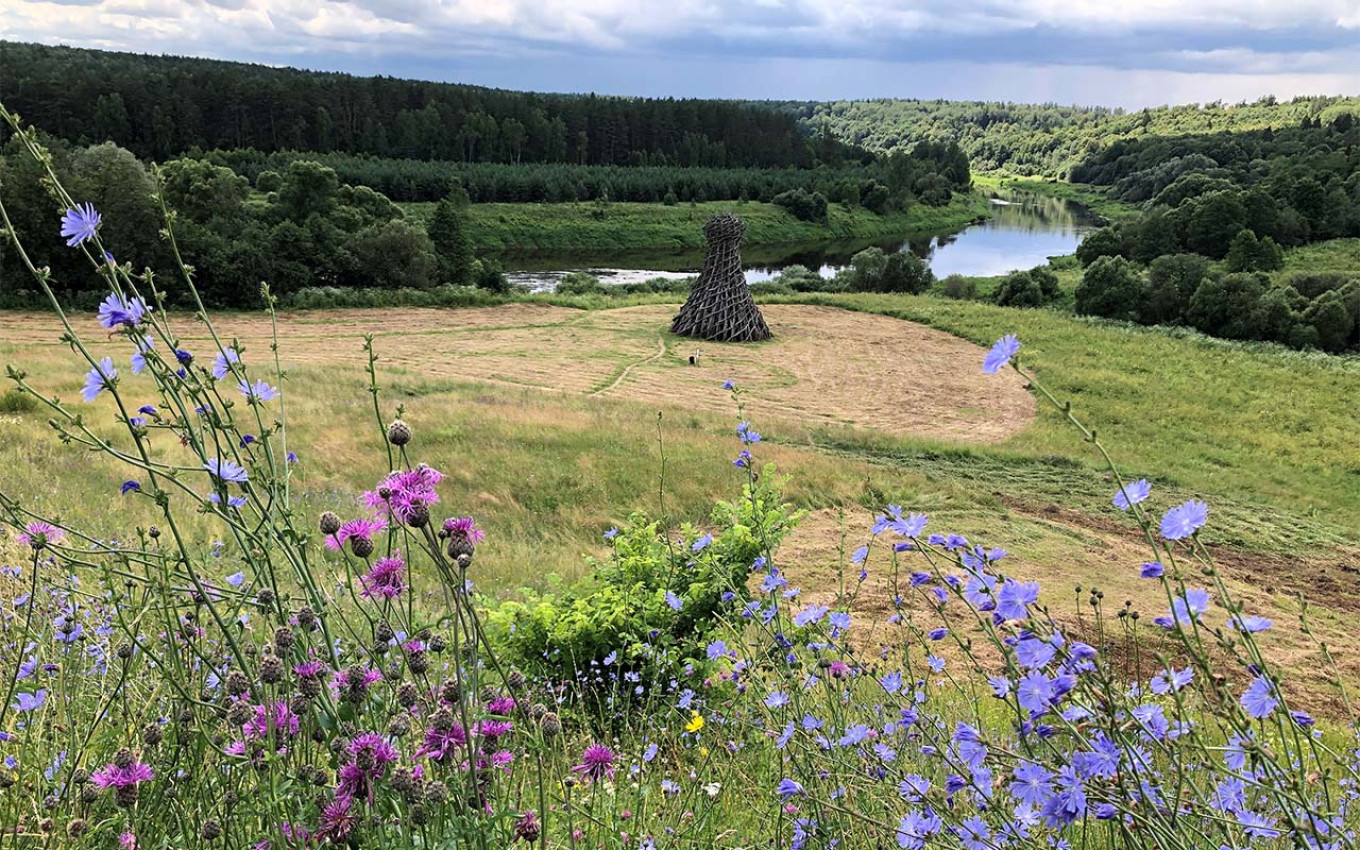
How to get there
Driving is the fastest and least risky option — it takes about three and a half hours to reach the park from central Moscow. There’s plenty of free parking throughout the park, and a car makes it easier to see the sights if time is limited.
If a car is out of the question, an express train will take you from Moscow’s Kievsky Railway Station to Kaluga in about two and a half hours — tickets cost about 700 rubles. From there, you can spend some time exploring the charming city of Kaluga before taking a taxi to Nikola-Lenivets for about 2,000 rubles. If you stop in Kaluga, I recommend coffee at 1554 and lunch or dinner at Taki Da, which serves Odessan cuisine and has a socially distanced veranda.
What to bring
- Bug spray. Nikola-Lenivets is nestled amid idyllic, untamed woodlands. But beneath these lush green canopies lie clouds of whining mosquitoes and horse flies the size of a school bus waiting to feast on your flesh. Don’t say I didn’t warn you.
- Comfortable walking shoes that you’re not afraid of getting dirty.
- Sunscreen and lightweight clothes.
- A swimsuit and towel if you’d like to take a dip in the river.
- Camping chairs or an outdoor blanket.
- Your dog.
Where to stay
There are several different styles of lodging available on the park grounds. In addition to a hostel, a guesthouse, tents and a number of small cottages, there are one-of-a-kind options like a constructivist capsule and a room that looks like a railway car.
Each option has a freshly renovated interior with an almost Scandinavian design sensibility. Most of them have free WiFi. No matter where you stay, you’ll have a comfortable bed with fresh white sheets and a set of towels.
The guesthouse, located in the tiny village of Koltsovo, is your best bet if you prefer to have a private room and don’t want to walk outside to use the bathroom or take a shower. The DublDom, a four-room house, is a great choice for large groups or families.
It’s also possible to bring your own tent and camp on the grounds at 600 rubles per night.
Rates vary depending on where you choose to stay as well as the number of guests, but most options are fairly affordable. You can explore the different accommodation options and book your stay here.
Note: If you’re staying in your own tent or one of the park’s deluxe tents, admission to the park costs 250 rubles per day.

Where to eat
Cafe Ugra is the park’s main dining location and where you’ll eat breakfast if you’re staying in guest housing. There are several breakfast options to choose from, including an eggs-and-sausage country breakfast, salmon toast, kasha (an oatmeal-like dish) or a plate of syrniki (fried Russian cakes made from tvorog served with jam and condensed milk). Breakfast also includes your choice of an espresso, americano or cappuccino. For lunch and dinner, Cafe Ugra offers a variety of dishes to suit all tastes (as well as vegetarian options), plus a large selection of juices, smoothies, tea, beer and more.
You can also rent bicycles and grilling equipment (and purchase ready-to-grill packs of meat and vegetables) here.
About a 10-minute walk down the road is the Ferma Cafe, a quaint farm-to-table spot that serves up fresh, vibrantly flavored takes on classic Russian dishes like okroshka, beetroot salad and more. The cafe serves drinks like coffees, kvas, lemonade, cider and beer. You can also buy fresh produce to take home — it’s all grown right here.
Both cafes have WiFi as well as indoor and outdoor seating, and are great places to recharge before hitting the trails again.
What to do
Hiking and biking
The park is a hiker's paradise: its trails wind through sprawling meadows and bone-white birch forest, follow the curve of the river and pass by the park’s myriad art objects. Upon arriving, you’ll be given a map of the park with the trails and main art installations highlighted.
If you want, you can also bring your bike or rent one from the park — the trails are great for biking, although there are a few steep spots marked on the map to watch out for. Renting a bike costs 500 rubles for the first three hours plus 150 rubles for each subsequent hour.
Even if you think you aren’t outdoorsy, here is a place where you can be at peace and find new appreciation for nature. And whatever you do, don’t miss the 50-meter-long trampoline.

Art workshop
If you’re interested in learning more about the artistic techniques behind the larger-than-life sculptures at Nikola-Lenivets, you can sign up for a master class with the park’s resident artists and craft your own miniature version of a Nikola-Lenivets art piece from wood — a great souvenir, especially for kids. Cost: 1,000 rubles.
Bee farm
Nikola-Lenivets is home to a bee farm where more than 40,000 busy but docile bees produce honey that you can purchase and take home. A guided tour of the bee colony includes a honey tasting session. The bee farm’s friendly owner, Vladimir, can show you around in Russian or English. Cost: 150 rubles.
Guided tours
The staff at Nikola-Lenivets offer guided tours that cover the history of the area, the story of Nikola-Lenivets’ creation and how the park’s artworks tie in to its philosophy of public art. Tours are offered in Russian and English, but English-language tours are limited — it’s best to check with the information desk when you arrive to see if or when they’ll be offered during your stay. Cost: 500 rubles.

Horseback riding
It’s also possible to explore Nikola-Lenivets’ artistic gems on horseback. A nearby stable offers guided horseback rides for adults and children that can take you along the river or to the park’s artworks. Cost: Varies depending on the number of people and the length of the ride. One hour for a single person cost 1,500 rubles.
On my last full day at the park I decided to try it.
My guide, a schoolgirl from Moscow named Marusya who spends her summers at Nikola-Lenivets and trains at an Olympic-level equestrian facility during the school year, led me on a path through the forest and fields on a grey, dewy morning.
My horse, a gentle brown mare named Kuplyusha, frequently paused to sneak bites of grass as we passed the mighty Beaubourg, a 22-meter formation of branches shaped into massive pipes that looks like a musical instrument designed for a giant or an alien spaceship.
After our ride, the horses returned to grazing in the tall grass, side by side. The two are “husband and wife,” Marusya explained, and are almost never apart from each other.
“I hope somebody loves me like this someday,” I remarked, only half joking.
“Dreams come true,” Marusya replied.
In a place as magical as this, how could I not believe her?
A Message from The Moscow Times:
Dear readers,
We are facing unprecedented challenges. Russia's Prosecutor General's Office has designated The Moscow Times as an "undesirable" organization, criminalizing our work and putting our staff at risk of prosecution. This follows our earlier unjust labeling as a "foreign agent."
These actions are direct attempts to silence independent journalism in Russia. The authorities claim our work "discredits the decisions of the Russian leadership." We see things differently: we strive to provide accurate, unbiased reporting on Russia.
We, the journalists of The Moscow Times, refuse to be silenced. But to continue our work, we need your help.
Your support, no matter how small, makes a world of difference. If you can, please support us monthly starting from just $2. It's quick to set up, and every contribution makes a significant impact.
By supporting The Moscow Times, you're defending open, independent journalism in the face of repression. Thank you for standing with us.
Remind me later.



